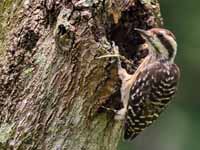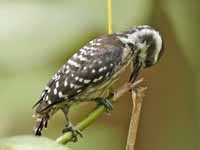The order Piciformes is made up of the woodpecker family Picidae plus 8 other families. Picidae make up about half of the species. In general, the Piciformes are insectivorous, but some exceptions eat mostly fruit. Nearly all Piciformes have parrot-like feet—two toes forward and two back, an arrangement that has obvious advantages for birds that spend much of their time on tree trunks. And most Piciformes do not have down feathers at any age, only true feathers. All nest in cavites.
Family Picidae: Woodpeckers and Allies
The woodpeckers family members are found almost worldwide. Most species live in forests or woodland habitats, although a few species are known to live in treeless areas such as rocky hillsides and deserts. They range in size from 8-50 cm. Many species exhibit patches of red and yellow on their heads and bellies, and these bright areas are important in signalling. Although the sexes of Picidae species tend to look alike, many have more prominent red or yellow head markings in males than in females.
Members of the family Picidae have strong bills for drilling and drumming on trees and long sticky tongues for extracting food. Species that use their bills in soil or for probing as opposed to regular hammering tend to have longer and more decurved bills. To prevent brain damage from the rapid and repeated decelerations, woodpeckers have evolved a number of adaptations to protect the brain. These include small brain size and the short duration of contact. The millisecond before contact with wood a thickened membrane closes, protecting the eye from flying debris. The nostrils are also protected, they are often slit-like and have special feathers to cover them. In addition to the strong claws and feet woodpeckers have short strong legs, this is typical of birds that regularly forage on trunks. The tails of most woodpeckers are stiffened, and when the bird perches on vertical surfaces, the tail and feet work together to support it. Picidae species can either be sedentary or migratory.
There are 7 articles pertaining to the woodpecker family Picidae: African, Eurasian, North America, South America, Small, Large, Terrestrial.
A wide variety of woodpeckers live iin Europe and Asia.
The pygmy woodpeckers of genus Yungipicus are small with a length between 13 and 16 cm. Most have dark brown upperparts with some white spots, pale underparts with some streaks, a dark eye-line, and a white supercilium. They commonly excavate a nest hole on the underside of a dead branch. All are found in Asia. At the other extreme, the Mulleripicus woodpeckers are large woodpeckers ranging from the southern sooty woodpecker with a length of 29 cm to the great slaty woodpecker that may be, at 50 cm, the world's largest woodpecker.
All of the twelve Dendrocopos woodpeckers are found in Asia, and two of theme are also found in Europe. All of the species will forage on standing trees, most will forage on fallen trees, and some will forage on the ground and even catch an insect on the fly. The pair excavates a nest cavity, most often in a tree. A few species will also use bamboo, and the white-winged woodpecker has been known to excavate in a sandhill. Except for one species, these woodpeckers are 16 to 26 cm long, which implies that some are just slightly bigger than the pybmy woodpeckers.
The following genera have one to 4 species: Blythipicus, Dendrocoptes, Gecinulus, Geocolaptes, Hemicircus, Jynx, Leiopicus, Meiglyptes, Micropternus, Reinwardtipicus.
Other Eurasian woodpeckers are included with the North America woodpeck article: crimson-breasted woodpecker (Dryobates cathpharius), lesser spotted woodpecker (Dryobates minor), and the Eurasian three-toed woodpecker (Picoides tridactylus). The Piculets article includes the speckled piculet (Picumnus innominatus), rufous piculet ( Sasia abnormis), and the white-browed piculet (Sasia ochracea) all three of which are very small, 10 cm or less. The Large Woodpeckers article includes the black woodpecker (Dryocopus martius), white-bellied woodpecker (Dryocopus javensis), 8 flamebacks in Chrysocolaptes, and 5 more flamebacks in Dinopium, The Terrestrial article has the greater yellownape (Chrysophlegma flavinucha) and Picus contains 11 more Eurasian woodpeckers.
Genus Blythipicus Found : southeast Asia, Malaysia
Woodpecker,_Bay Blythipicus pyrrhotis
Description: The bay woodpecker has dark brown upperparts with narrow rufous bars on the mantle and wider rufous bars towards the rump. The upper-tail is barred dark brown and rufous. It has a brown head with a lighter face. The male has some rufous on the head while the female does not. The underparts are dark brown and the bill is yellow. The nest is excavated by both parents in a live or dead tree. They share incubation and feeding of the chicks. The bay woodpecker is 27 to 30 cm long.
Range: China, Indian subcontinent, southeast Asia, Malaysia.
Habitat: Dense growth in forests, also bamboo groves.
Diet: Termites, ants, beetle larvae, also other insects and some berries.
Conservation status: Least Concern.
Image by: 1) Raju_Kasambe Range: China, Indian subcontinent, southeast Asia, Malaysia.
Habitat: Dense growth in forests, also bamboo groves.
Diet: Termites, ants, beetle larvae, also other insects and some berries.
Conservation status: Least Concern.
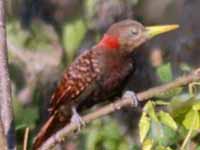
Woodpecker,_Maroon Blythipicus rubiginosus
Description: The maroon woodpecker has dark maroon upperparts with some light barring. It has an olive-brown head. The male has rufous on the hind-crown, side of neck, and possibly the malar region. The female has less rufous showing on the head. They have dark brown underparts. The bill is yellow. The maroon woodpecker is 23 to 24 cm long.
Range: Brunei, Indonesia, Malaysia, Myanmar, Singapore, Thailand.
Habitat: Primary forests with dense undergrowth. Also plantations.
Diet: Insect larvae, especially that of beetles.
Conservation status: Least Concern.
Image by: 1) Nana_Hale - BorneoRange: Brunei, Indonesia, Malaysia, Myanmar, Singapore, Thailand.
Habitat: Primary forests with dense undergrowth. Also plantations.
Diet: Insect larvae, especially that of beetles.
Conservation status: Least Concern.
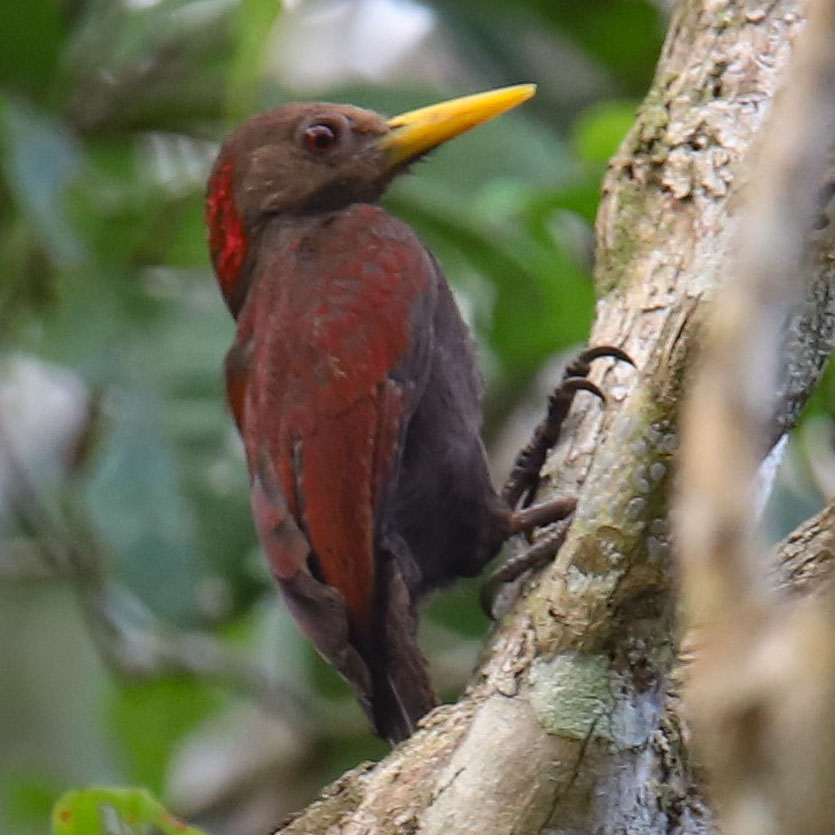
Genus Dendrocoptes
The Dendrocoptes woodpeckers are found mainly mainly in Asia, but also Europe. They excavate their nest cavities in a tree trunk or branch usually choosing where the wood is dead, but also occasionally in living wood. The Dendrocoptes woodpeckers are 20 to 22 cm long.
Woodpecker,_Arabian Dendrocoptes dorae
Description: The Arabian woodpecker has olive-grey to brown upperparts streaked with white. It has a brownish or pale grey head. The male has a bright red patch on the rear-crown. The underparts a grey streaked with white and there is a hint of red on the belly. The Arabian woodpecker is about 18 cm long. The nest is excavated in dead wood which my be part of a living tree.
Range: The southwest Arabian peninsular.
Habitat: Woodland habitats including patches of date palm, evergreen riparian forested corridors, shade trees in coffee plantations, in orchards, on terraced cropland with isolated trees, and in woods.
Diet: Insect larvae, spiders, aphids, fig-wasps, and flying insects.
Conservation status: It is listed as Near Threatedn because of deforestation for expanded agriculture and charcoal production.
Image by: 1) P_Khoo Range: The southwest Arabian peninsular.
Habitat: Woodland habitats including patches of date palm, evergreen riparian forested corridors, shade trees in coffee plantations, in orchards, on terraced cropland with isolated trees, and in woods.
Diet: Insect larvae, spiders, aphids, fig-wasps, and flying insects.
Conservation status: It is listed as Near Threatedn because of deforestation for expanded agriculture and charcoal production.
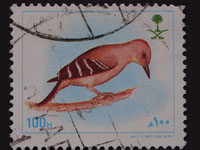
Woodpecker,_Brown-fronted Dendrocoptes auriceps
Description: The brown-fronted woodpecker has black upperparts with white barring, black-streaked white underparts, and a black nape. The male has a brown fore-crown, yellow center-crown, and red rear-crown. The female has yellow crown. The brown-fronted woodpecker is 20 cm long.
Range: Afghanistan, India, Nepal, Pakistan and Bhutan.
Habitat: Moist montane forests.
Diet: Insects and their larvae, caterpillars. Also, fruit and pine seeds. Forages in trees by gleaning and pecking.
Conservation status: Least Concern.
Image by: 1, 2) Nabarunsadhya 3) Patty McGann 4) Dr. Caesar PhotographyRange: Afghanistan, India, Nepal, Pakistan and Bhutan.
Habitat: Moist montane forests.
Diet: Insects and their larvae, caterpillars. Also, fruit and pine seeds. Forages in trees by gleaning and pecking.
Conservation status: Least Concern.
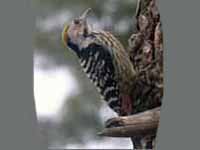
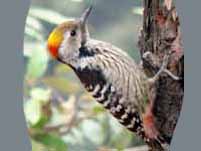
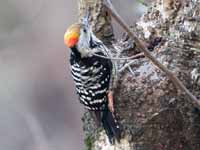
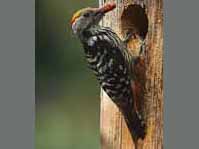
Woodpecker,_Middle-spotted Dendrocoptes medius
Description: The middle-spotted woodpecker has a black mantle, large white shoulder patch, and black flight feathers with large white spots. It has a red crown which is duller for the female. There is a diagonal black line from the nape to the top of breast. It has white cheeks and underparts. The middle-spotted woodpecker is 20 to 22 cm long. It is similar to the great spotted woodpecker which has a black malar stripe and has a black crown.
Range: Europe and western Asia.
Habitat: Prefers deciduous forest regions, especially areas with old oak, hornbeam and elm, and a patchwork of clearings, pasture and dense woodland.
Diet: Insects and its larvae. Also sap. It forages by gleaning more than pecking.
Conservation status: Least Concern.
Image by: 1) Frank Vassen - Poland 2) Andrej_Chudy - Solvakia 3) Sergey Yeliseev - RussiaRange: Europe and western Asia.
Habitat: Prefers deciduous forest regions, especially areas with old oak, hornbeam and elm, and a patchwork of clearings, pasture and dense woodland.
Diet: Insects and its larvae. Also sap. It forages by gleaning more than pecking.
Conservation status: Least Concern.
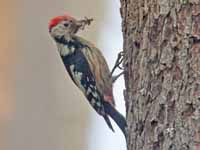
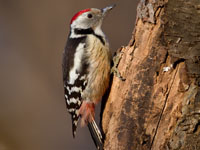

Genus Dendrocopos
All of the twelve Dendrocopos woodpeckers listed here are found in Asia, and two of theme are also found in Europe. All of the species will forage on trees, most will forage on fallen trees, and some will forage on the ground and even catch and insect on the fly. The pair excavates a nest cavity, most often in a tree. A few species will also use bamboo, and the white-winged woodpecker has been known to excavate in a sandhill.
Except for one species, these woodpeckers are 16 to 26 cm long. To put these numbers in perspective, the pygmy woodpeckers of genus Yungipicus have lengths between 13 and 16 cm, so some of the Dendrocopos woodpeckers are just slightly larger than pygmy woodpeckers. On the other hand, the Okinawa woodpecker is up to 36 cm long making it a rather large woodpecker!
Except for one species, these woodpeckers are 16 to 26 cm long. To put these numbers in perspective, the pygmy woodpeckers of genus Yungipicus have lengths between 13 and 16 cm, so some of the Dendrocopos woodpeckers are just slightly larger than pygmy woodpeckers. On the other hand, the Okinawa woodpecker is up to 36 cm long making it a rather large woodpecker!
Woodpecker,_Darjeeling Dendrocopos darjellensis
Description: The Darjeeling woodpecker has black upperparts with white patches on the sides, a white or yellow face, yellow neck sides, black malar stripes extending to neck upper-breast, a white-barred black tail, and yellow-buff underparts with black streaks. The male has a red nape patch. The Darjeeling woodpecker is about 24 cm long.
Range: Bhutan, India, Myanmar, Nepal and Tibet.
Habitat: Cloud forests, open woodland. It is usually above 1500 meters.
Diet: Insect larvae. Also adult insects. It gleans and pecks on trees and fallen logs.
Conservation status: Least Concern.
Image by: 1) Francesco Verronesi - Bhutan 2) Brendan Ryan - Myanmar 3) Ajit_HotaRange: Bhutan, India, Myanmar, Nepal and Tibet.
Habitat: Cloud forests, open woodland. It is usually above 1500 meters.
Diet: Insect larvae. Also adult insects. It gleans and pecks on trees and fallen logs.
Conservation status: Least Concern.
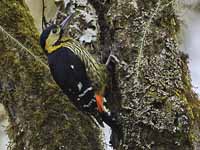
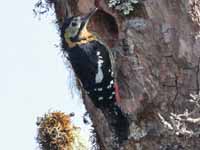

Woodpecker,_Freckle-breasted Dendrocopos analis
Description: The freckle-breasted woodpecker has black upperparts with white bars. The underparts are buff with faint bars on the flanks. The crown is red for the male and he has an orange forehead. These areas are black for the female. There is a black malar stipe that ends in a black patch. The freckle-breasted woodpecker is 16 to 18 cm long.
Range: Indonesia, Laos, Myanmar, Thailand, Vietnam.
Habitat: Open woodlands or open country with scattered trees.
Diet: Ants and other insects including their larvae. Also scorpions, fruit. They feed mainly on stading trees, but also on fallen logs, and some will take arthropods on the ground.
Conservation status: Least Concern.
Image by: 1) Ariefrahman - Thailand 2) Peter_StewardRange: Indonesia, Laos, Myanmar, Thailand, Vietnam.
Habitat: Open woodlands or open country with scattered trees.
Diet: Ants and other insects including their larvae. Also scorpions, fruit. They feed mainly on stading trees, but also on fallen logs, and some will take arthropods on the ground.
Conservation status: Least Concern.
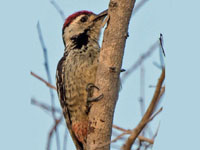
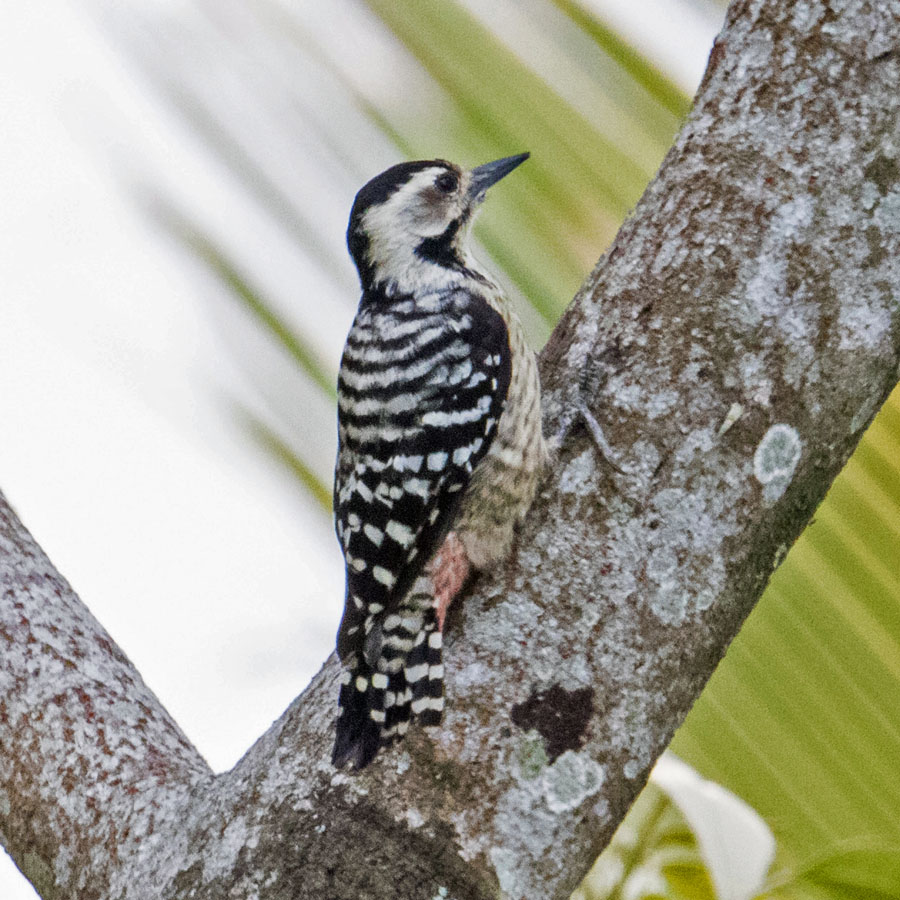
Woodpecker,_Fulvous-breasted Dendrocopos macei
Description: The fulvous-breasted woodpecker has white-barred black upperparts. It has a whitish face and neck. The breast is buff and the belly pinkish. The cap is red for the male and black for the female. There is a black malar stripe that meets a black patch at the neck and then continues to the upper-breast. The fulvous-breasted woodpecker is 18 to 20 cm long.
Range: Indian subcontinent, Myanmar.
Habitat: Forest openings and edges, secondary growth, areas with scattered trees.
Diet: Ants and other insects including their larvae. Also scorpions, fruit. It forages in trees by gleaning and pecking, but will come to the ground for ants.
Conservation status: Least Concern.
Image by: 1, 4) JM Garg - India 2) Pralso known assh Chakraborty 3) Arindam MitraRange: Indian subcontinent, Myanmar.
Habitat: Forest openings and edges, secondary growth, areas with scattered trees.
Diet: Ants and other insects including their larvae. Also scorpions, fruit. It forages in trees by gleaning and pecking, but will come to the ground for ants.
Conservation status: Least Concern.
1, 2) Female 3, 4) Male

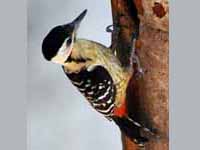
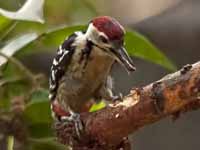
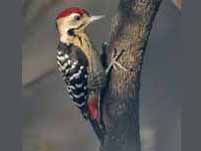
Woodpecker,_Great Spotted Dendrocopos major
Description: The great spotted woodpecker has black upperparts and crown. It has a white forehead, cheeks, breast, and upper belly plus a large white shoulder patch. It has a reddish lower belly and under-tail coverts, a black bill, and greenish grey legs. There is a black X shaped pattern on the side of the head that extends toward the chest. The male has a red spot on the nape. The great spotted woodpecker is 20 to 24 cm long. It has a bold black pattern in side of head while the similar Syrian woodpecker has much less face markings. The similar white-winged woodpecker has a more extensive white wing patch.
Range: Europe, Asia. It is absent only from those areas too cold or dry to have suitable woodland habitat.
Habitat: It is found in a wide variety of woodlands, broadleaf, coniferous or mixed, and in modified habitats such as parks, gardens and olive groves.
Diet: Beetle larvae, adult insects, spiders, carrion. seeds, acorns.
Conservation status: Least Concern.
Image by: 1) Jan_Svetlik 2) Andrej_Chudy - Slovakia 3) Andre
Chatroux 4) Andy_MorffewRange: Europe, Asia. It is absent only from those areas too cold or dry to have suitable woodland habitat.
Habitat: It is found in a wide variety of woodlands, broadleaf, coniferous or mixed, and in modified habitats such as parks, gardens and olive groves.
Diet: Beetle larvae, adult insects, spiders, carrion. seeds, acorns.
Conservation status: Least Concern.
1, 2) Female 3, 4) Male
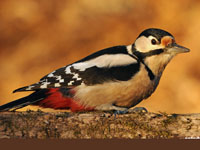
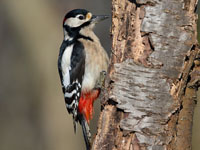
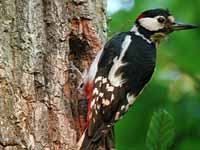
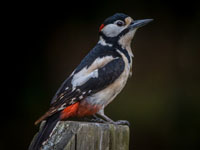
Woodpecker,_Himilayan Dendrocopos himalayensis
Description: The Himalayan woodpecker has black upperparts with a large white patch from each shoulder towards mid-body. The crown is red (male) or black (female). It has an off-white face with a black malar stripe and black vertical ear-covert stripe. The nape is black. The Himilayan woodpecker is 23 to 25 cm long.
Range: Afghanistan, India, Nepal, and Pakistan.
Habitat: Varied forests.
Diet: Larvae from beetles, insects, conifer seeds, sap. Forages almost exclusively in trees via gleaning and pecking.
Conservation status: Least Concern.
Image: 1) Imran_Shah - Pakistan 2) Mike_Prince 3) Prateik_Kulkarni 4) Imran_Shah - PakistanRange: Afghanistan, India, Nepal, and Pakistan.
Habitat: Varied forests.
Diet: Larvae from beetles, insects, conifer seeds, sap. Forages almost exclusively in trees via gleaning and pecking.
Conservation status: Least Concern.
1) Female 2, 3) Male
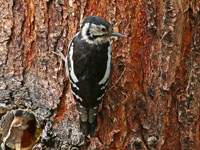



Woodpecker,_Okinawa Dendrocopos noguchii
Description: The Okinawa woodpecker has mainly dark brown upperparts with dull red feather-tips which causes the rump and upper-tail coverts to have a reddish tinge. It has white spots on the primaries. The head is paler than the upperparts as is the head. The male has dark-red crown and the female has a blackish-brown crown. The Okinawa woodpecker is 31 to 35 cm long.
Range: Okinawa (Japan).
Habitat: Broadleaf forests, secondary forests, large trees in mostly cleared areas.
Diet: Beetle larvae, spiders, moths, centipedes, fruit. Forages low in trees, on stumps and fallen branches. The male will also take arthropods from the ground.
Conservation status: It is listed as Critically Endangered due to active use of American military planes which disturbs and even kills the birds.
Image by: 1) John Gerard Keulemans 2) P_Khoo 3) rapayotan 4) Amateras7777.Range: Okinawa (Japan).
Habitat: Broadleaf forests, secondary forests, large trees in mostly cleared areas.
Diet: Beetle larvae, spiders, moths, centipedes, fruit. Forages low in trees, on stumps and fallen branches. The male will also take arthropods from the ground.
Conservation status: It is listed as Critically Endangered due to active use of American military planes which disturbs and even kills the birds.
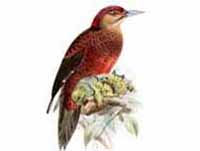
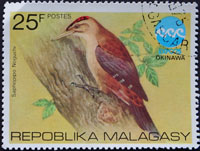
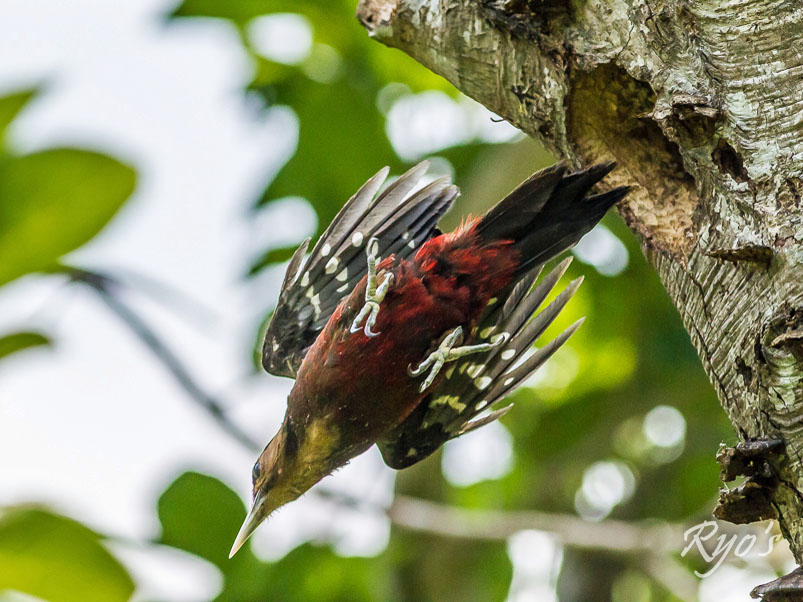
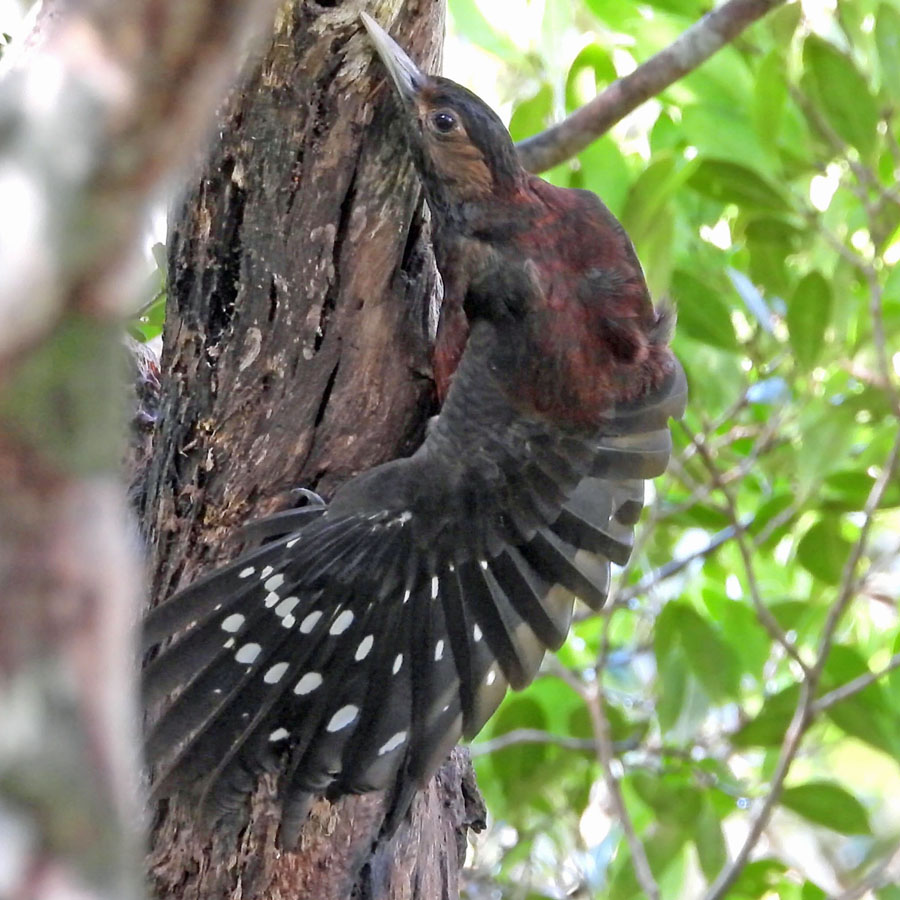
Woodpecker,_Rufous-bellied Dendrocopos hyperythrus
Description: The rufous-bellied woodpecker has rufous underparts and a rufous head with a white face. The upperparts are black with white bars.The male has a red crown while the female has a black crown which is speckled with white. The rufous-bellied woodpecker is 20 to 23 cm long.
Range: The Himalayas in the Indian Subcontinent, southeast Asia.
Habitat: Forest from 500 m to 4000 m.
Diet: Insects and larvae that are found on trees. Also sap. Forages by gleaning and pecking.
Conservation status: Least Concern.
Image by: 1) Ron Knight 2) Dr Caesar Photography 3) Francesco Veronesi - Bhutan 4) David CookRange: The Himalayas in the Indian Subcontinent, southeast Asia.
Habitat: Forest from 500 m to 4000 m.
Diet: Insects and larvae that are found on trees. Also sap. Forages by gleaning and pecking.
Conservation status: Least Concern.
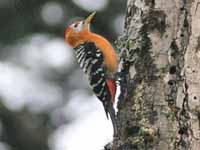

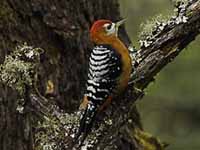
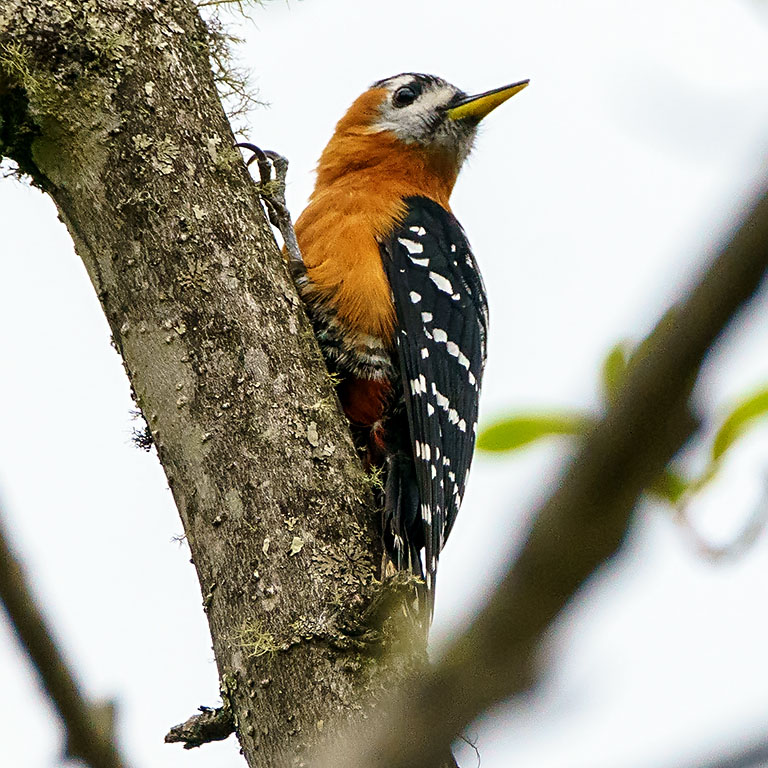
Woodpecker,_Sind Dendrocopos assimilis
Description: The sind woodpecker has black upperparts with a large white wing patch. A black malar stripe joins a black stripe that goes from the upper-breast to the nape. The male has a red crown and nape while for the female they are black. The underparts are white. The sind woodpecker is 20 to 22 cm long.
Range: India, Iran, and Pakistan.
Habitat: Forests, rural gardens and plantations, thorny shrub-lands, dry scrub-lands.
Diet: Insects, including wood-boring beetles, larvae, spiders and ants.
Conservation status: Least Concern.
Image by: 1) Thomas_Douglas Range: India, Iran, and Pakistan.
Habitat: Forests, rural gardens and plantations, thorny shrub-lands, dry scrub-lands.
Diet: Insects, including wood-boring beetles, larvae, spiders and ants.
Conservation status: Least Concern.
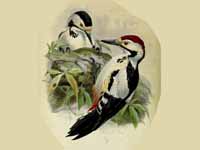
Woodpecker,_Stripe-breasted Dendrocopos atratus
Description: The stripe-breasted woodpecker has black upperparts with bold white bars. The male has a red crown and nape while for the female they are black. The face is white with a black malar stripe which ends on the upper-breast. The throat and underparts are greyish-yellow with dark streaks. The stripe-breasted woodpecker is 22 cm long.
Range: Bhutan, China, India, Laos, Myanmar, Thailand, and Vietnam.
Habitat: Montane forests and their edges; also more open areas with scattered trees.
Diet: Insects such as ants and beetle larvae.
Conservation status: Least Concern.
Image by:2) Jerry Oldenettel - Thailand 3) Jason_Thompson - Thailand 4) Vijay_IsmavelRange: Bhutan, China, India, Laos, Myanmar, Thailand, and Vietnam.
Habitat: Montane forests and their edges; also more open areas with scattered trees.
Diet: Insects such as ants and beetle larvae.
Conservation status: Least Concern.
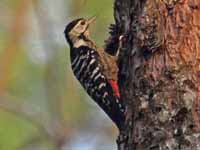
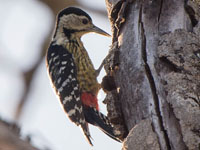
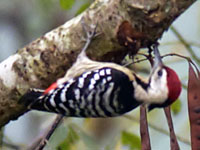
Woodpecker,_Syrian Dendrocopos syriacus
Description: The Syrian woodpecker has black upperparts and crown. It has a large white shoulder patch and white forehead, cheeks, breast, and upper belly. The lower belly and under-tail coverts are reddish, the bill is black, and the legs greenish-grey. There is a diagonal black line from base of bill to nape. The male has a crimson spot on his nape while the female does not. The Syrian woodpecker is 23 cm long. The similar great spotted woodpecker has a bold black pattern in side of head.
Range: Southern Europe, southwest Asia.
Habitat: Open woodlands, cultivation with trees and scrubs, and parks.
Diet: Wood boring larvae; also seeds, nuts, berries, sap. Forages in trees, on the ground, and can take insects on the wing.
Conservation status: Least Concern.
Image by: 1) Vitaliy Khustochka - Ukraine 2) Ofer Faigon - Israel 3) Francesco Veronesi - Hungary Range: Southern Europe, southwest Asia.
Habitat: Open woodlands, cultivation with trees and scrubs, and parks.
Diet: Wood boring larvae; also seeds, nuts, berries, sap. Forages in trees, on the ground, and can take insects on the wing.
Conservation status: Least Concern.
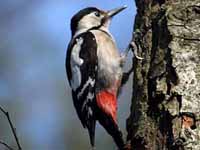
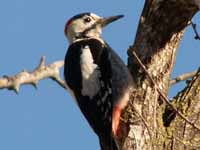
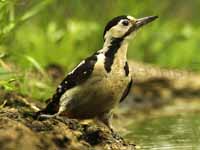
Woodpecker,_White-backed Dendrocopos leucotos
Description: The white-backed woodpecker has a black back with much white on it. There is a black cresent on the side of face which has a line extending towards the shoulder. The male has a red crown while the female has black crown. The white-backed woodpecker is 24 to 26 cm
Range: Central Europe through central Asia.
Habitat: Open forests with dead trees available.
Diet: Mainly wood-boring beetles and their larvae. Also other insects, nuts, seeds, berries. Favorite foraging is on trunks of dead trees. Males forage on live trees more often than females.
Conservation status: Least Concern.
Image by:1, 3) Sergey Yelisee - Moscow 2) David_Cook - Taiwan 4) Hiyashi_Halso Range: Central Europe through central Asia.
Habitat: Open forests with dead trees available.
Diet: Mainly wood-boring beetles and their larvae. Also other insects, nuts, seeds, berries. Favorite foraging is on trunks of dead trees. Males forage on live trees more often than females.
Conservation status: Least Concern.
1, 2) Female 3, 4) Male
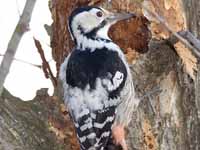
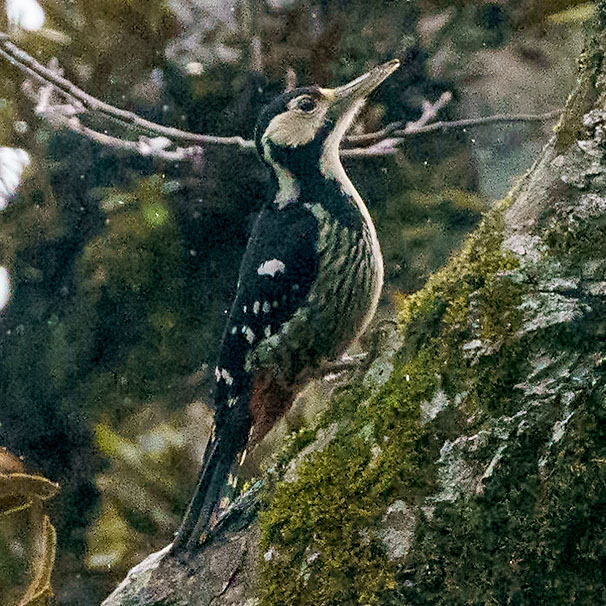
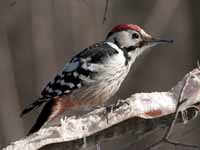
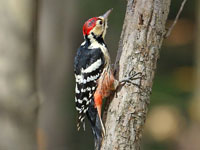
Woodpecker,_White-winged Dendrocopos leucopterus
Description: The white-winged woodpecker has mainly black upperparts with a large white patch visible on the wings while at rest. The face is white with a black cresent which connects to a black partial collar. The male has a black crown and red nape while the female has both areas black. The underparts are white. The white-winged woodpecker is 22 to 23 cm long.
Range: Afghanistan, China, Iran, Kazakhstan, Tajikistan, Turkmenistan, Uzbekistan.
Habitat: Lowland forests. Prefers willow and popalars. Also found in desert scrub, gardens with trees nearby.
Diet: Insects and their larvae.
Conservation status: Least Concern.
Image by: 1) Alastair Rae 2) Sergey Yeliseev Range: Afghanistan, China, Iran, Kazakhstan, Tajikistan, Turkmenistan, Uzbekistan.
Habitat: Lowland forests. Prefers willow and popalars. Also found in desert scrub, gardens with trees nearby.
Diet: Insects and their larvae.
Conservation status: Least Concern.
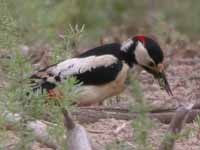
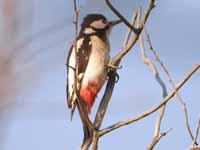
Genus Gecinulus Found : southeast Asia
Woodpecker,_Bamboo Gecinulus viridis
Description: The bamboo woodpecker has yellowish-green upperparts with a red tinge near the rump. The male has brown face, red crown, and red nape. The female has a greenish-yellow crown. They have olive-brown underparts. The bamboo woodpecker is 25 to 26 cm long.
Range: Laos, Malaysia, Myanmar, Thailand, and Vietnam.
Habitat: Woodlands that include bamboo groves.
Diet: Ants that are usually found on bamboo. Forages mainly by gleaning with occasional pecking.
Conservation status: Least Concern.
No images available.Range: Laos, Malaysia, Myanmar, Thailand, and Vietnam.
Habitat: Woodlands that include bamboo groves.
Diet: Ants that are usually found on bamboo. Forages mainly by gleaning with occasional pecking.
Conservation status: Least Concern.
Woodpecker,_Pale-headed Gecinulus grantia
Description: The pale-headed woodpecker has mainly greenish-brown plumage. It has a pale yellowish-green head. The males has a red tinge to the crown. The pale-headed woodpecker is 25 to 27 cm long.
Range: China, Indian subcontinent, southest Asia.
Habitat: Favors bamboo, but also likes forests and scrub.
Diet: Larvae of insects. Also ants. Forages in lower level of trees and on their trunks; rarely on the ground.
Conservation status: Least Concern.
Image by: 1) Francesco_Veronesi - BhutanRange: China, Indian subcontinent, southest Asia.
Habitat: Favors bamboo, but also likes forests and scrub.
Diet: Larvae of insects. Also ants. Forages in lower level of trees and on their trunks; rarely on the ground.
Conservation status: Least Concern.

Genus Geocolaptes - 1 species
Woodpecker,_Ground Geocolaptes olivaceus
Description: The ground woodpecker has greyish-brown upperparts with pale spotting (bolder towards rump), a red rump (visible in flight), and buff underparts with a red tinge. It has a grey head, pale yellow eyes, and a pale throat. Male and female are similar, but the female has slightly less red than the male.
Range: southern Africa.
Habitat: Rocky areas.
Diet: Mainly of ants with their eggs, larvae and pupae. Also termites, beetles, and other insects. Forages mainly on the ground searching for ants and their colonies.
Conservation status: It is listed as Near Threatened because the population appears to be declining.
Image by: 1) Ian White - South Africa 2) Alan Manson- South Afica 3) Paul Barnard - South Africa 4) Francesco_VeronesiRange: southern Africa.
Habitat: Rocky areas.
Diet: Mainly of ants with their eggs, larvae and pupae. Also termites, beetles, and other insects. Forages mainly on the ground searching for ants and their colonies.
Conservation status: It is listed as Near Threatened because the population appears to be declining.
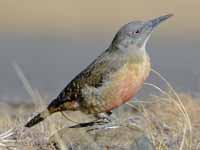
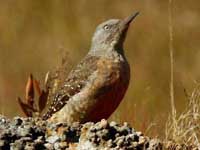
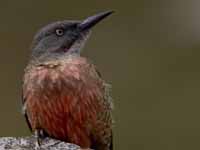
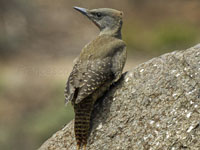
Genus Hemicircus
These two woodpecker species have a black and white back with distinctive patterns. The grey-and-buff woodpecker has scalloped patterns and the heart-spotted woodpecker has some black heart-shaped spots on a white background. Both species are found in southern Asia.
Woodpecker,_grey-and-buff Hemicircus concretus
Description: The grey-and-buff woodpecker has blackish upperparts with white edges producing a scallop effect. The head is mostly grey with a thin white line from the cheek to the mantle. The male has a red forehead and fore-crest. It has a grey neck and underparts. The bill is dark grey. The grey-and-buff woodpecker is about 13.5 cm long.
Range: Brunei, Indonesia, Malaysia, Myanmar, Singapore, and Thailand.
Habitat: Rainforests, especially edges and clearings. Also plantations, cleared areas with trees available.
Diet: Insects, fruit, berries. It forages by gleaning.
Conservation status: Least Concern.
Image by: 1, 2) Lip Kee - Malaysia Range: Brunei, Indonesia, Malaysia, Myanmar, Singapore, and Thailand.
Habitat: Rainforests, especially edges and clearings. Also plantations, cleared areas with trees available.
Diet: Insects, fruit, berries. It forages by gleaning.
Conservation status: Least Concern.
1, 2) Female
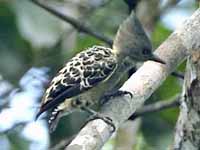

Woodpecker,_Heart-spotted Hemicircus canente
Description: The heart-spotted woodpecker has black and white plumage. In particular, it has white wing-coverts with heart-shaped black marks. The male has black forehead, crown; these areas are white of the female. The heart-spotted woodpecker is 15 to 17 cm long.
Range: Southern Asia.
Habitat: Forests and their edges, open woodlands, bamboo groves, plantations.
Diet: Ants, termites and their larvae. Other insects. Forages by gleaning and pecking.
Conservation status: Least Concern.
Range: Southern Asia.
Habitat: Forests and their edges, open woodlands, bamboo groves, plantations.
Diet: Ants, termites and their larvae. Other insects. Forages by gleaning and pecking.
Conservation status: Least Concern.
Image by: 1) Shrikant_Rao - India 2) Blaise_Droz 3) Rejichandran
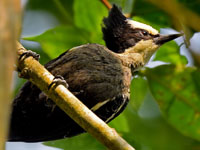
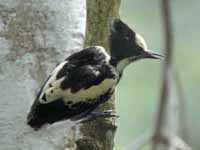
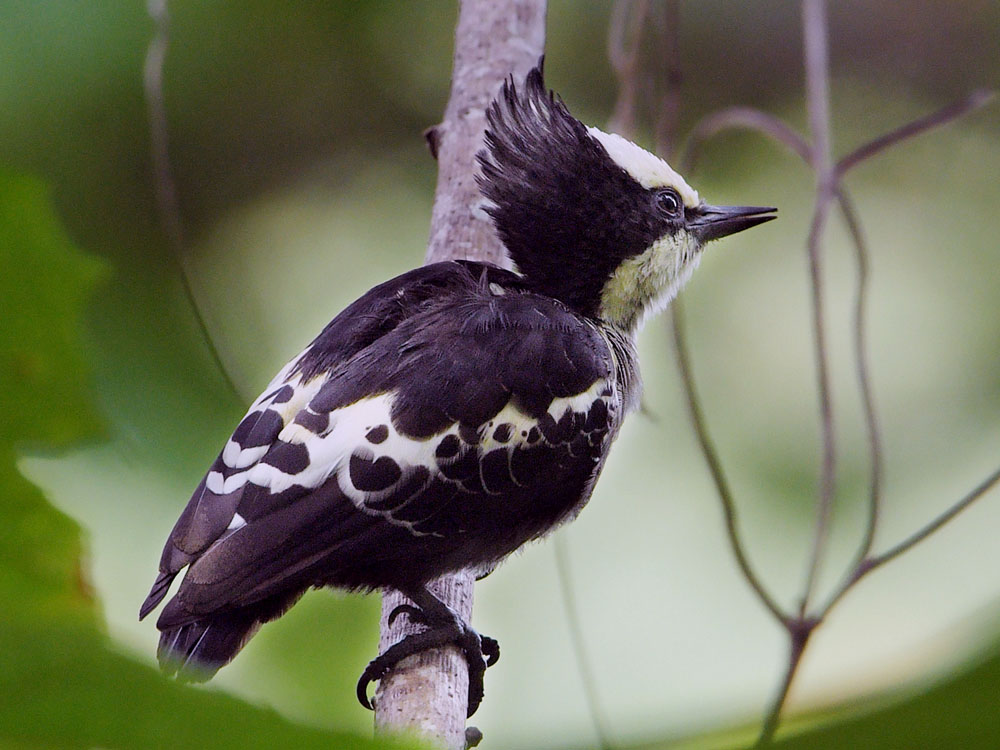
Genus Jynx Found : Africa, Asia, Europe
The wrynecks lack stiff tail feathers as they more likely to perch on a branch than cling to a tree trunk. Their favorite food is ants which they find in decaying wood or on the ground. They get their name from their ability to rotate their head almost 180 degrees. They are small woodpeckers, ranging from 17 to 19 cm in length.
Wryneck,_Eurasian Jynx torquilla
Description: The Eurasian wryneck has barred and mottled upperparts in shades of pale brown and rufous. It has a grey crown and nape, dark eye-line, and whitish thin supercilium. The underparts are cream speckled spotted with brown streaks. The Eurasian wryneck is about 17 cm long. The nesting cavity may be an existing hole in a tree, wall, or banking.
Range: Europe, Asia, Africa. The Eurasian wryneck is the only European woodpecker to undertake long-distance migrations.
Habitat: Open woodlands, grassy areas with scattered trees. Prefers drier areas.
Diet: Ants, beetles, and their larvae. Also other insects.
Conservation status: Least Concern.
Image by: 1) Ron Knight 2) Imran_Shah - Pakistan 3) Martien Brand - Netherlands 4) naturalhistorymanRange: Europe, Asia, Africa. The Eurasian wryneck is the only European woodpecker to undertake long-distance migrations.
Habitat: Open woodlands, grassy areas with scattered trees. Prefers drier areas.
Diet: Ants, beetles, and their larvae. Also other insects.
Conservation status: Least Concern.
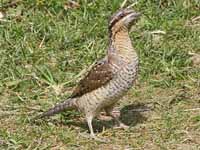
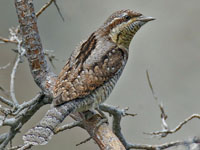
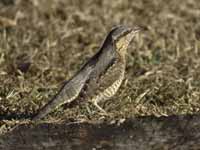
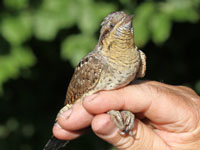
Wryneck,_Rufous-necked Jynx ruficollis
Description: The rufous-necked wryneck, also known as the red-thoated wryneck, has mainly cryptic upperparts, with intricate patterning of greys and browns. It has a rufous throat and upper-breast. The underparts are whitish with thin brown streaks. It is the non-migratory counterpart of the Eurasian wryneck. The rufous-necked wryneck is 19 cm long.
Range: Sub-Saharan Africa.
Habitat: Woodlands, forest edges, treed grasslands.
Diet: Ants and their larvae; other insects.
Conservation status: Least Concern.
Image by: 1) Steve Garvie 2, 3, 4) Derek_Keats - South AfricaRange: Sub-Saharan Africa.
Habitat: Woodlands, forest edges, treed grasslands.
Diet: Ants and their larvae; other insects.
Conservation status: Least Concern.
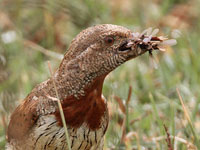
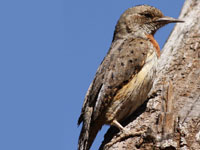
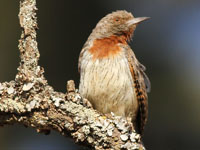

Genus Leiopicus - 1 species
This species was formerly place with the Dendrocopos species. They are the yellow-crowned woodpecker's nearest relatives, but the Dendrocopos woodpeckers are significantly larger.
Woodpecker,_Yellow-crowned Leiopicus mahrattensis
Description: The yellow-crowned woodpecker has black upperparts with white barring and spots, and an off-white face. The underparts are off-white with dark streaks which are less prominent on the breast. There is a red belly patch. The male has a scarlet nape and yellow fore-crown while the female has a yellowish nape, and crown. The yellow-crowned woodpecker is 17 to 18 cm long.
Range: Indian Subcontinent.
Habitat: Dry woodland, desert scrub.
Diet: Insect larvae and adult insects. Also fruit. It forages in trees, rarely coming to the ground.
Conservation status: Least Concern.
Image by: 1) T Monk 2, 3) JM Garg - India 4) Hari_PatibandaRange: Indian Subcontinent.
Habitat: Dry woodland, desert scrub.
Diet: Insect larvae and adult insects. Also fruit. It forages in trees, rarely coming to the ground.
Conservation status: Least Concern.
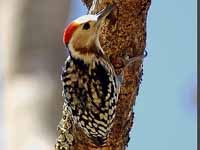
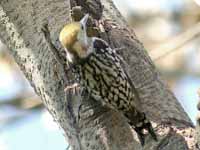

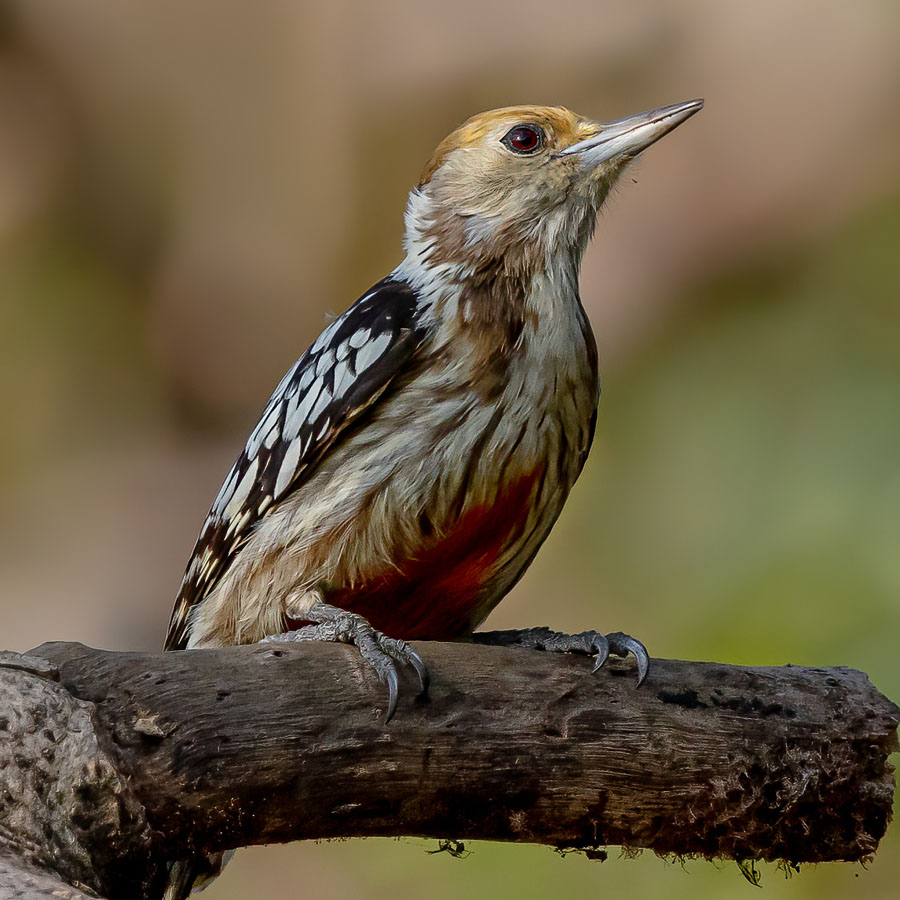
Genus Meiglyptes Found : southeast Asia
Woodpecker,_Black-and-buff Meiglyptes jugularis
Description: The black-and-buff woodpecker has mainly black upperparts with the mantle surrounded by a white oval. The head and throat are mainly black with buff shading and the underparts are black. The male has some red in the malar region. The black-and-buff woodpecker is about 22 cm long.
Range: Cambodia, Laos, Myanmar, Thailand, and Vietnam.
Habitat: Evergreen forests, favoring more open area. Also bamboo.
Diet: Ants and other insects.
Conservation status: Least Concern.
Image by: 1) Gee - Cambodia 2) Jerry Oldenettel - Thailand Range: Cambodia, Laos, Myanmar, Thailand, and Vietnam.
Habitat: Evergreen forests, favoring more open area. Also bamboo.
Diet: Ants and other insects.
Conservation status: Least Concern.
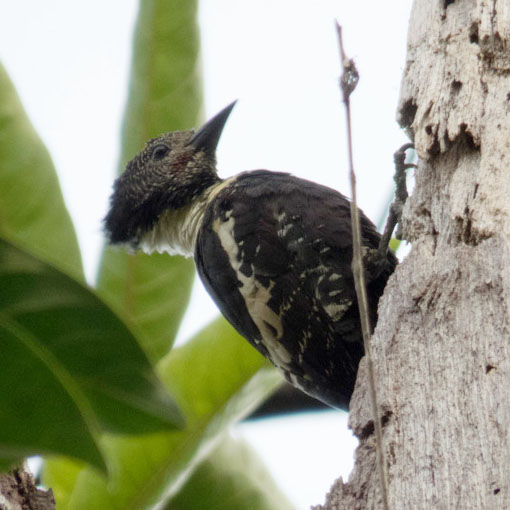
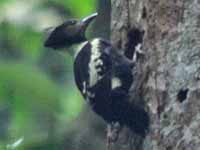
Woodpecker,_Buff-necked Meiglyptes tukki
Description: The buff-necked woodpecker has dark olive-brown upperparts with thin buff bars. It has a dark head. The male has a red malar stripe. There is a wide cream-color stripe continuing from the malar stripe to the shoulder. The underparts are blackish and the bill is black. The buff-necked woodpecker is about 21 cm long.
Range: Southeast Asia: Brunei, Indonesia, Malaysia, Myanmar, Singapore, and Thailand.
Habitat: Moist forests and forested swamps.
Diet: Ants, termites and their larvae. It forages mainly by gleaning, occasionally pecking.
Conservation status: It is listed as Near Threatened because of habit loss.
Image by: 1) Marcel Holyoak - Malaysia 2) Francesco_Veronesi - ThailandRange: Southeast Asia: Brunei, Indonesia, Malaysia, Myanmar, Singapore, and Thailand.
Habitat: Moist forests and forested swamps.
Diet: Ants, termites and their larvae. It forages mainly by gleaning, occasionally pecking.
Conservation status: It is listed as Near Threatened because of habit loss.
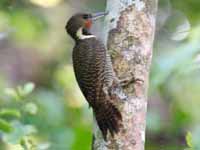
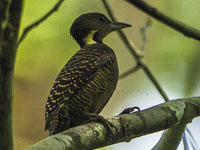
Woodpecker,_Buff-rumped Meiglyptes tristis
Description: The buff-rumped woodpecker has black upperparts with white or buff barring depending on the subspecies. Similarly the rump can be cream or buff colored. It has greyish-brown with rusty-buff vermiculations on the crest, neck, and upper-breast. The male has a red malar patch. The underparts are mainly blackish with black and buff barred flanks. The buff-rumped woodpecker is 17 to 18 cm long.
Range: Southeast Asia: Brunei, Indonesia, Malaysia, Myanmar, Singapore, and Thailand.
Habitat: Forest edges and opennings, second growth forest, treed-swamps.
Diet: Ants and other insects. Forages in trees, mainly by gleaning and infrequently pecking.
Conservation status: It is listed as Endangered as the subspecies white-rumped woodpecker is very rare in its small range.
Image by: 1) Junis SP Photography 2, 3) Hiyashi Halso known as - MalaysiaRange: Southeast Asia: Brunei, Indonesia, Malaysia, Myanmar, Singapore, and Thailand.
Habitat: Forest edges and opennings, second growth forest, treed-swamps.
Diet: Ants and other insects. Forages in trees, mainly by gleaning and infrequently pecking.
Conservation status: It is listed as Endangered as the subspecies white-rumped woodpecker is very rare in its small range.
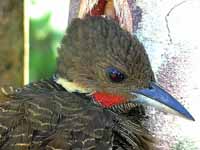
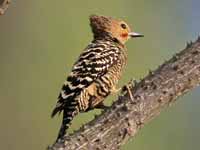
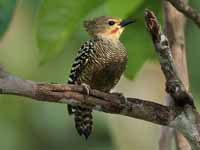
Genus Micropternus - 1 species
Woodpecker,_Rufous Micropternus brachyurus
Description: The rufous woodpecker has rufous plumage with the upperparts, including the upper-tail, having fine black barring. The mantle has less barring than the lower-back. The lower-flanks have some faint barring. The male has small red red-tipped feathers on the face, especially on the malar region. The rufous woodpecker is 25 cm long. The nest is excavated in a tree, often in an ant nest that is located in the tree.
Range: Indian Subcontinent.
Habitat: Forests, open areas with some trees available, plantations.
Diet: Mainly ants which if gleans on trees and also on the ground. Also termites and other insects, nectar.
Conservation status: Least Concern.
Range: Indian Subcontinent.
Habitat: Forests, open areas with some trees available, plantations.
Diet: Mainly ants which if gleans on trees and also on the ground. Also termites and other insects, nectar.
Conservation status: Least Concern.
Image by: 1) Patko_Erika 2) Kia BoHe 4) Yunus_Mony
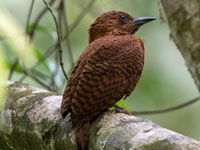
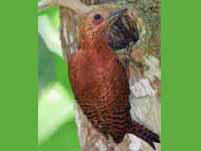

Genus Mulleripicus Found: southeast Asia
The Mulleripicus woodpeckers are large woodpeckers ranging from the southern sooty woodpecker with a length of 29 cm to the great slaty woodpecker that at 50 cm might be the world's largest woodpecker.
Woodpecker,_Ashy Mulleripicus fulvus
Description: The ashy woodpecker has grey-brown to dark slate-grey upperparts. The throat and underparts are buff, but they may have a reddish stain due to foraging. The bill is black bill. The male has red on the front part of its head and the female has a grey head. The ashy woodpecker is a large long-tailed woodpecker with a length of 40 cm.
Range: Sulawesi and surrounding islands in Indonesia.
Habitat: Forests, secondary forests.
Diet: Termites and other insects. Forages mainly on trees, but probably also on terrestrial termite nests.
Conservation status: Least Concern.
Image by: 1) Collaertsbrothers 2) Francesco_Veronesi 3) Sergey_YeliseevRange: Sulawesi and surrounding islands in Indonesia.
Habitat: Forests, secondary forests.
Diet: Termites and other insects. Forages mainly on trees, but probably also on terrestrial termite nests.
Conservation status: Least Concern.
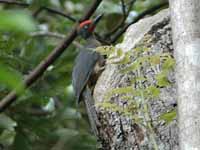
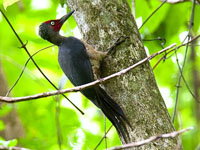
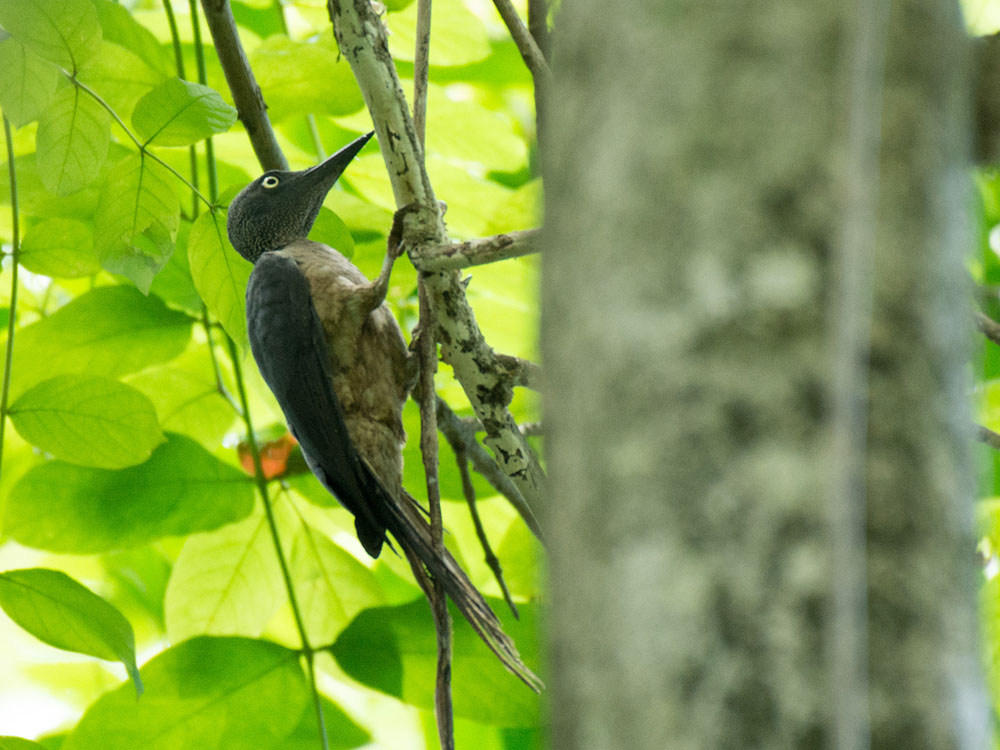
Woodpecker,_Great Slaty Mulleripicus pulverulentus
Description: The great slaty woodpecker has mainly dark grey plumage with some white spots. The throat and front of the face are a pale yellow or whitish. The male has a red malar striope. With a length of about 50 cm and a weight of sometimes more than 500 grams it may be the world's largest woodpecker. The nest cavity is excavated by both sexes high in a tree.
Range: Indian subcontinent and Southeast Asia.
Habitat: Primary and secondary forests that are semi-open, treed swamps, mangroves, open areas with scattered tall trees.
Diet: Ants, other insects, fruit.
Conservation status: It is listed as Vulnerable as the population is declining due to forest destruction and fragmentation of its range.
Image by: 1) Naturelly 2) Brendan Ryan - Thailand 3) Dibyendu_AshRange: Indian subcontinent and Southeast Asia.
Habitat: Primary and secondary forests that are semi-open, treed swamps, mangroves, open areas with scattered tall trees.
Diet: Ants, other insects, fruit.
Conservation status: It is listed as Vulnerable as the population is declining due to forest destruction and fragmentation of its range.
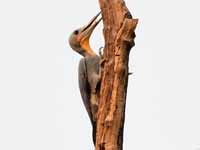
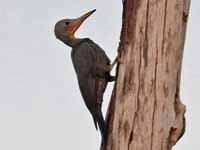
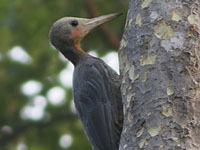
Woodpecker,_Northen Sooty Mulleripicus funebris
Description: The northern sooty woodpecker has glossy bluish-black upperparts with some subspecies also having white dots. The underparts are slightly lighter and unglossed. The male has a dark red fore-crown and malar region. The female's has a black head with some fine white spots. The eyes are yellow as is the bill. The northern sooty woodpecker is 30 to 32 cm.
Range: Luzon, Marinduque, Catanduanes and the Polillo Island.
Habitat: Forests plus their edges and clearing. Also disturbed forest, cultivated areas with tall trees available.
Diet: Insects which are foraged in trees.
Conservation status: It is listed as Near Threatened due to deforestation.
Image by: 1) Lip KeeRange: Luzon, Marinduque, Catanduanes and the Polillo Island.
Habitat: Forests plus their edges and clearing. Also disturbed forest, cultivated areas with tall trees available.
Diet: Insects which are foraged in trees.
Conservation status: It is listed as Near Threatened due to deforestation.
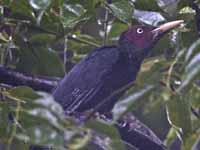
Woodpecker,_Southen Sooty Mulleripicus fuliginosus
The southern sooty woodpecker has greyish-black plumage with the underparts paler. There are some white dots on the head, especially the throat. The male has a red malar region. The eyes are yellow as is the bill. The northern sooty woodpecker is 29 to 30 cm.
Range: Luzon, Marinduque, Catanduanes and the Polillo Island.
Habitat: Forests plus their edges and clearing. Also secondary forests.
Diet: Insects which are foraged in trees.
Conservation status: It is listed as Vulnerable due to deforestation.
No images available.Range: Luzon, Marinduque, Catanduanes and the Polillo Island.
Habitat: Forests plus their edges and clearing. Also secondary forests.
Diet: Insects which are foraged in trees.
Conservation status: It is listed as Vulnerable due to deforestation.
Genus Reinwardtipicus - 1 species
Woodpecker,_Orange-backed Reinwardtipicus validus
Description: The orange-backed woodpecker, when the wings are folded, has mainly dark brown upperparts due to the wing-coverts and flight feathers. The hind-neck is white, the mantle is yellow to orange, and the rump is orange to red. The underparts are brown with red feather-tips. The male has a red fore-crown, brown rear-crown, and orange-brown face. The female hs a dark brown crown and nape and grey-brown face. The orange-backed woodpecker is 30 cm long.
Range: Indonesia, Thailand.
Habitat: Forests, disturbed woodlands, open areas with some dead trees.
Diet: Ants, caterpillars, beetle larvae, other insects.
Conservation status: Least Concern.
Image by: 1) Temminck 2) Naturelly Range: Indonesia, Thailand.
Habitat: Forests, disturbed woodlands, open areas with some dead trees.
Diet: Ants, caterpillars, beetle larvae, other insects.
Conservation status: Least Concern.
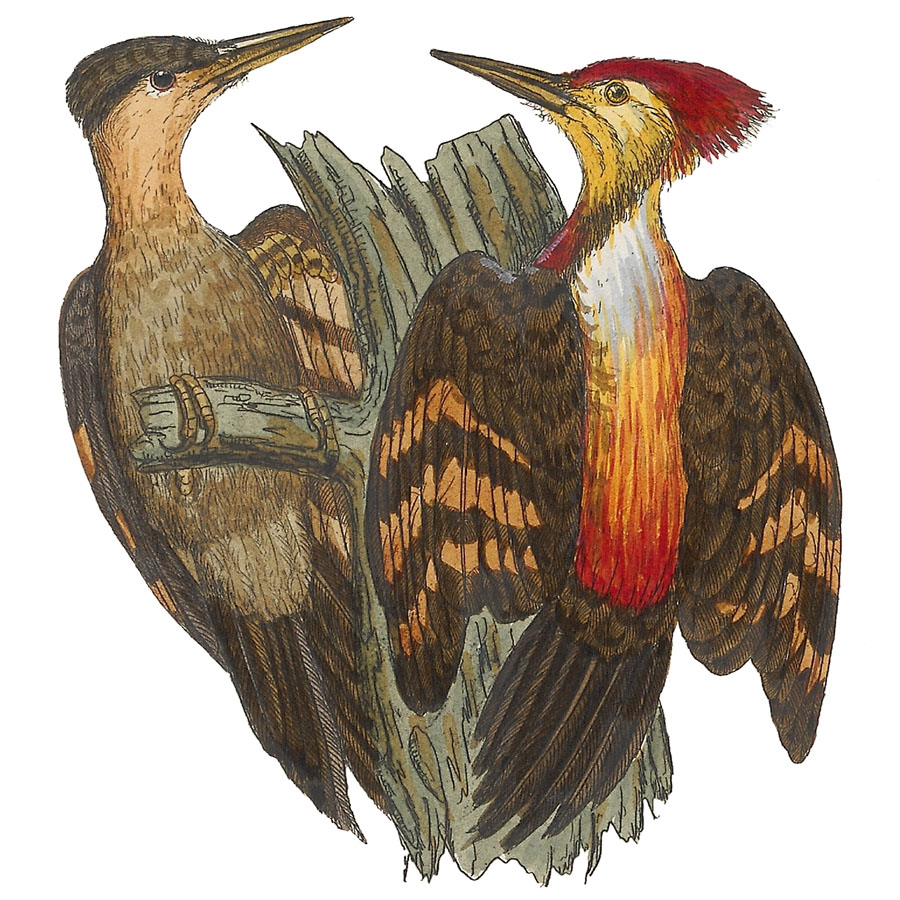

Genus Yungipicus
As their name implies, these seven pygmy woodpeckers are small with a length between 13 and 16 cm. Most have dark brown upperparts with some white spots, and pale underparts with some streaks. Most have a dark eye-line and a white supercilium. They commonly excavate a nest hole on the underside of a dead branch. They are all found in Asia.
Woodpecker,_Brown-capped Pygmy Yungipicus nanus
Description: The brown-capped pygmy woodpecker has white-barred brown upperparts, a brown cap (edged red for males), and a brown eye-line. It has a white supercilium and white underparts with faint brown streaks, The brown-capped pygmy woodpecker is 13 cm long.
Range: India, Nepal, Pakistan, Sri Lanka.
Habitat: Forests with opennings, second growth forests, trees in cultivated areas and parks.
Diet: Mainly larvae and adults of ants, termites, beetles. Also fruits, nectar.
Conservation status: Least Concern.
Image by: 1) Lip Kee - Singapore 2) Shyamai - India 3) Hari_Patibanda - IndiaRange: India, Nepal, Pakistan, Sri Lanka.
Habitat: Forests with opennings, second growth forests, trees in cultivated areas and parks.
Diet: Mainly larvae and adults of ants, termites, beetles. Also fruits, nectar.
Conservation status: Least Concern.
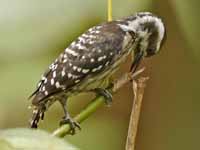
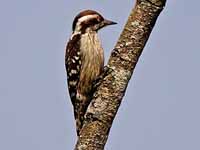

Woodpecker,_grey-capped Pygmy Yungipicus canicapillus
Description: The grey-capped pygmy woodpecker has black upperparts with white spots, buff underparts with dark barring, a dark grey crown bordered with black, and a white face with dark eye-line plus a thin dark malar stripe. The male has a red nape. The grey-capped pygmy woodpecker is 14 to 16 cm long.
Range: Southeast and eastern Asia.
Habitat: Subtropical or tropical lowland, montane and mangrove forests.
Diet: Mainly larvae and adults of ants, termites, beetles. Also fruits, seeds.
Conservation status: Least Concern.
Image by: 1, 2, 3) H1yashi Halso known as 4) Lin_Sun_Fong - TaiwanRange: Southeast and eastern Asia.
Habitat: Subtropical or tropical lowland, montane and mangrove forests.
Diet: Mainly larvae and adults of ants, termites, beetles. Also fruits, seeds.
Conservation status: Least Concern.

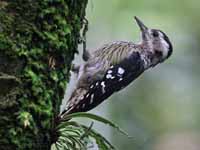
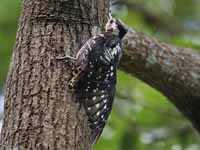
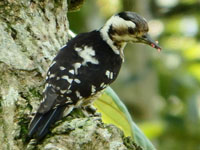
Woodpecker,_Japanese Pygmy Yungipicus kizuki
Description: The smallest of the Yungipicus woodpeckers, the Japanese pygmy woodpecker has dark brown upperparts with white bars. It has a grey-brown crown and malar stripe which has a white stripe above. The ear coverts are brown and a thin white supercilium extends to the nape where it meets a white vertical stripe. The underparts are white with variable brown streaks. The Japanese pygmy woodpecker is 13 to 15 cm long. The nest is usually excavated in a rottem tree stump.
Range: Russia, China, North Korea, South Korea and Japan.
Habitat: Many types of coniferous and deciduous forests, including lowland, upland and riverine forests, and also parks and gardens.
Diet: Ants, caterpillars, aphids, spiders, and berries.
Conservation status: Least Concern.
Image by: 1) Alastair Rae 2) coniferconifer 3) Francesco Veronesi - Japan 4) Laitche - Osalso known asRange: Russia, China, North Korea, South Korea and Japan.
Habitat: Many types of coniferous and deciduous forests, including lowland, upland and riverine forests, and also parks and gardens.
Diet: Ants, caterpillars, aphids, spiders, and berries.
Conservation status: Least Concern.
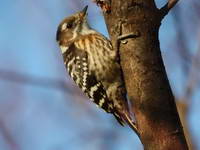
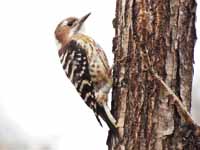

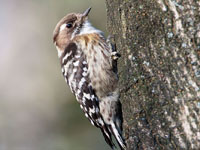
Woodpecker,_Phlippine_Pygmy Yungipicus maculatus
Description: The Philippine pygmy woodpecker has dark brown upperparts with white bars. It has a dark brown crown, a brown and wide eye-line with a white supercilium above, white cheeks below, and a dark brown malar stipe. The chin is white and the underparts are also white with brown streaks. The male has a small red patch at the edge of the rear-crown. The Philippine pygmy woodpecker is 13 to 14 cm long.
Range: Philippines.
Habitat: Subtropical or tropical lowland and montane forests.
Diet: Insects, mainly ants, and larvae.
Conservation status: Least Concern.
Image by: 1) John_GouldRange: Philippines.
Habitat: Subtropical or tropical lowland and montane forests.
Diet: Insects, mainly ants, and larvae.
Conservation status: Least Concern.
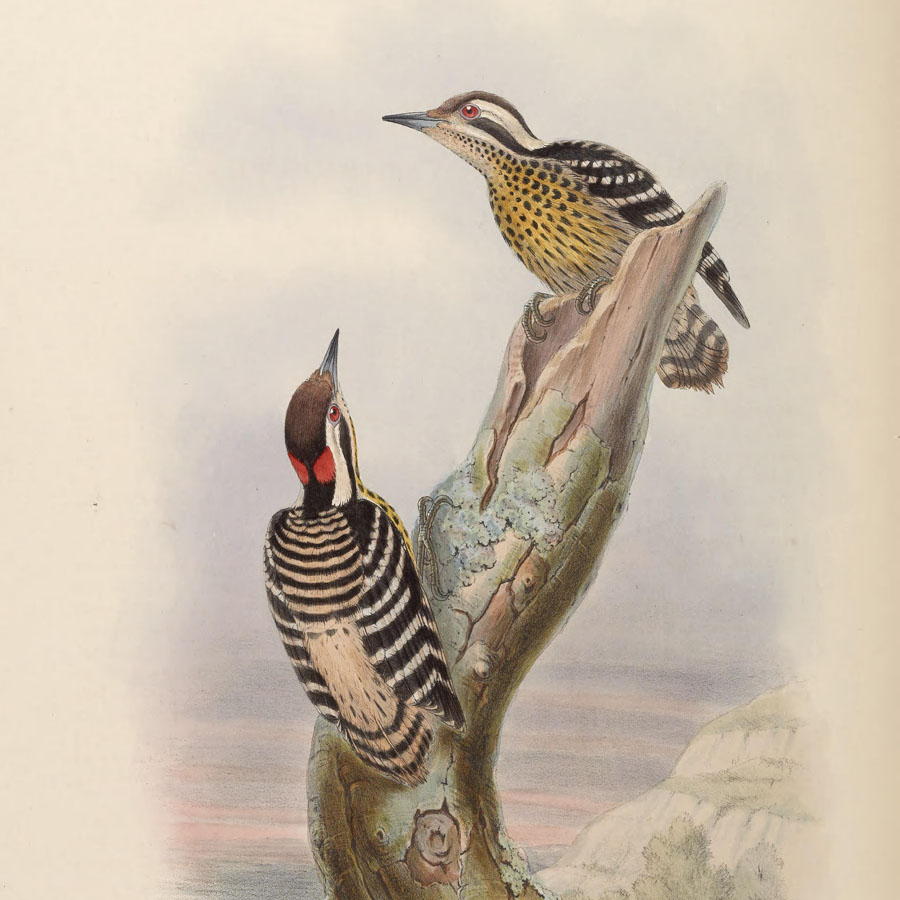
Woodpecker,_Sulawesi Pygmy Yungipicus temminckii
Description: The Sulawesi pygmy woodpecker has olive brown upperparts with white barring and a whitish rump with dark brown bars. The head is mainly brown with a short white supercilium and a broad white cheek bank extending towards the nape. The underparts are streaked brown and white becoming more white along the belly. The Sulawesi pygmy woodpecker is 13 to 14 cm long.
Range: Sulawesi in Indonesia.
Habitat: Subtropical or tropical lowland and montane forests.
Diet: Probably mainly ants, other insects, and larvae.
Conservation status: Least Concern.
Image by: 1) John Gould 2) AS_KonoRange: Sulawesi in Indonesia.
Habitat: Subtropical or tropical lowland and montane forests.
Diet: Probably mainly ants, other insects, and larvae.
Conservation status: Least Concern.
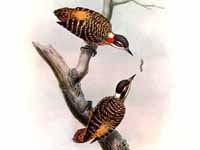
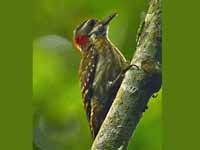
Woodpecker,_Sulu Pygmy Yungipicus ramsayi
Description: The Sulu pygmy woodpecker, also known as the Sulu woodpecker, has dark brown upperparts with some white spots on the back. The male has a dark brown crown with some red of the rear of the crown and the nape is entirely red. The female has brown instead of red. It has a wide white supercilium, dark brown eye-line which is bordered below by a white line and next a brown malar stripe. It has white underparts with some brown on the breast and buff streaks on the belly. The Sulu pygmy woodpecker is 13 to 14 cm long.
Range: Philippines.
Habitat: Lowland forests at edges and clearings, mangroves
Diet: Probably mainly insects.
Conservation status: It is listed as Vulnerable as its population is declining in its small range.
Image by: 1) Joseph_SmitRange: Philippines.
Habitat: Lowland forests at edges and clearings, mangroves
Diet: Probably mainly insects.
Conservation status: It is listed as Vulnerable as its population is declining in its small range.
1) Female left, male right
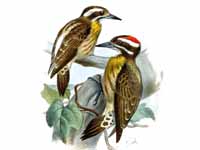
Woodpecker,_Sunda Pygmu Yungipicus moluccensis
Description: The Sunda pygmy woodpecker has greyish-brown upperparts with white spots, a greyish-brown crown, a white face with a long brown eye-line. The underparts are whitish with light brown streaking. The Sunda pygmy woodpecker is 13 cm long.
Range: Brunei, Indonesia, Malaysia, Singapore.
Habitat: Subtropical or tropical forests, mangroves.
Diet: Insects, mainly ants, beetles and their larvae. Also fruit and nectar.
Conservation status: Least Concern.
Image by: 1) Seshadri - Singapore 2) Ron_Knight - Bali, Indonesia 3) Lip_kee - SingaporeRange: Brunei, Indonesia, Malaysia, Singapore.
Habitat: Subtropical or tropical forests, mangroves.
Diet: Insects, mainly ants, beetles and their larvae. Also fruit and nectar.
Conservation status: Least Concern.
